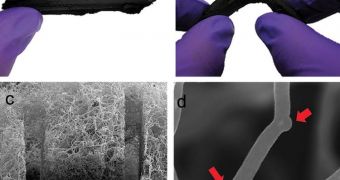Scientists at the US Department of Energy's (DOE) Oak Ridge National Laboratory (ORNL) have managed to use computational simulations developed in-house to create a new type of sponge that is perfect for removing oil residues from water.
The material is based on carbon nanotubes (CNT), extremely small wires that come together to form a special type of mesh. These thin filaments can be obtained from single-atom-thick sheets of graphene, which are rolled and then welded into cylinders.
CNT are among the strongest materials out there today, and exhibit a great potential for high electrical conductivity. They are also extremely lightweight, which makes them ideal for a wider variety of practical applications.
Since constructing nanotubes is a very complex scientific process (plagued by numerous limitations), researchers first had to develop a way of growing large clumps of the thin wires. ORNL investigator Bobby Sumpter was part of a larger team that managed to achieve this objective.
CNT can now be grown in large clumps by creating a pure carbon lattice, and then selectively substituting boron atoms within this structure. For this study, Sumpter worked closely with expert Vincent Meunier, who is now based at the Rensselaer Polytechnic Institute (RPI).
In order to conduct the necessary simulations, the team used a number of supercomputers, including one at the ORNL Leadership Computing Facility. These models were meant to reveal how the addition of boron atoms would influence the structure of the nanotubes.
“Any time you put a different atom inside the hexagonal carbon lattice, which is a chicken wire-like network, you disrupt that network because those atoms don't necessarily want to be part of the chicken wire structure,” Sumpter explains.
“Boron has a different number of valence electrons, which results in curvature changes that trigger a different type of growth,” he adds. Details of the new investigation were published in the latest issue of the esteemed journal Nature Scientific Reports.
“Instead of a forest of straight tubes, you create an interconnected, woven sponge-like material. Because it is interconnected, it becomes three-dimensionally strong, instead of only one-dimensionally strong along the tube axis,” the ORNL expert concludes.

 14 DAY TRIAL //
14 DAY TRIAL //